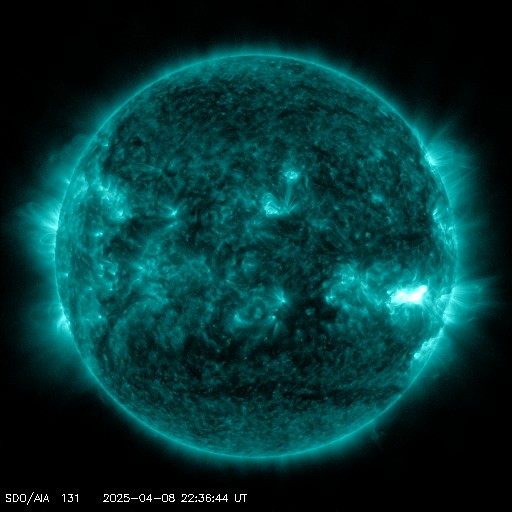Viewing archive of Saturday, 19 October 2024
Geophysical report
Solar and Geophysical Activity Summary 2024 Oct 19 0245 UTCPrepared by the NOAA © SWPC and processed by SpaceWeatherLive.com
Joint USAF/NOAA Solar and Geophysical Activity Summary
SGAS Number 293 Issued at 0245Z on 19 Oct 2024 This report is compiled from data received at SWO on 18 OctA. Energetic Events
Begin Max End Rgn Loc Xray Op 245MHz 10cm Sweep 0238 0238 0238 420 0242 0242 0242 110 0245 0245 0245 110 0311 0311 0311 150 0313 0313 0313 100 1728 1736 1741 3854 M1.1 1927 1938 1943 3854 S06W76 M4.8 Sn 2256 2301 2313 3852 C2.0 II 2313 2328 2338 3852 S11W80 M4.7 Sf II 2329 2329 2329 170
B. Proton Events
None.
C. Geomagnetic Activity Summary
The geomagnetic field reached
active levels.
D. Stratwarm
Not available
E. Daily Indices: (real-time preliminary/estimated values)
10 cm 165 SSN 132 Afr/Ap 010/011 X-ray Background C1.3 Daily Proton Fluence (flux accumulation over 24 hrs) GT 1 MeV 3.6e+05 GT 10 MeV 1.4e+04 p/(cm2-ster-day) (GOES-18 satellite synchronous orbit W137 degrees) Daily Electron Fluence GT 2 MeV 1.30e+07 e/(cm2-ster-day) (GOES-16 satellite synchronous orbit W75 degrees) 3 Hour K-indices Boulder 3 2 1 2 3 4 3 3 Planetary 3 2 0 1 3 3 4 3
F. Comments
None.
All times in UTC
Current data suggests there is a slight possibility for aurora to appear at the following high latitude regions in the near future
NorilskLatest news
Latest forum messages
Sunspot Latitudes at or near Solar Maximum 86AR4048 128Incoming & Unnumbered Active Regions 1678New satellites - Proba-3, PUNCH, SWFO-L1, GOES-U/19 47AR 4054 21
More topicsSupport SpaceWeatherLive.com!
A lot of people come to SpaceWeatherLive to follow the Sun's activity or if there is aurora to be seen, but with more traffic comes higher server costs. Consider a donation if you enjoy SpaceWeatherLive so we can keep the website online!

Latest alerts
08:12 UTC - Hemispheric Power Index
The OVATION model predicts the Hemispheric Power Index to reach 76GW at 08:57 UTC
02:00 UTC - Geomagnetic activity
Minor G1 geomagnetic storm (Kp5) Threshold Reached: 01:45 UTC
Tuesday, 8 April 2025
23:57 UTC - Hemispheric Power Index
The OVATION model predicts the Hemispheric Power Index to reach 50GW at 00:44 UTC
22:42 UTC - Solar flare
Moderate M1.57 flare
22:24 UTC - Radio Blackout
Minor R1 radio blackout in progress (≥M1 - current: M1.52)
Space weather facts
| Last X-flare | 2025/03/28 | X1.1 |
| Last M-flare | 2025/04/08 | M1.5 |
| Last geomagnetic storm | 2025/04/06 | Kp5 (G1) |
| Spotless days | |
|---|---|
| Last spotless day | 2022/06/08 |
| Monthly mean Sunspot Number | |
|---|---|
| March 2025 | 134.2 -20.4 |
| April 2025 | 148.6 +14.4 |
| Last 30 days | 137.1 -0.2 |




